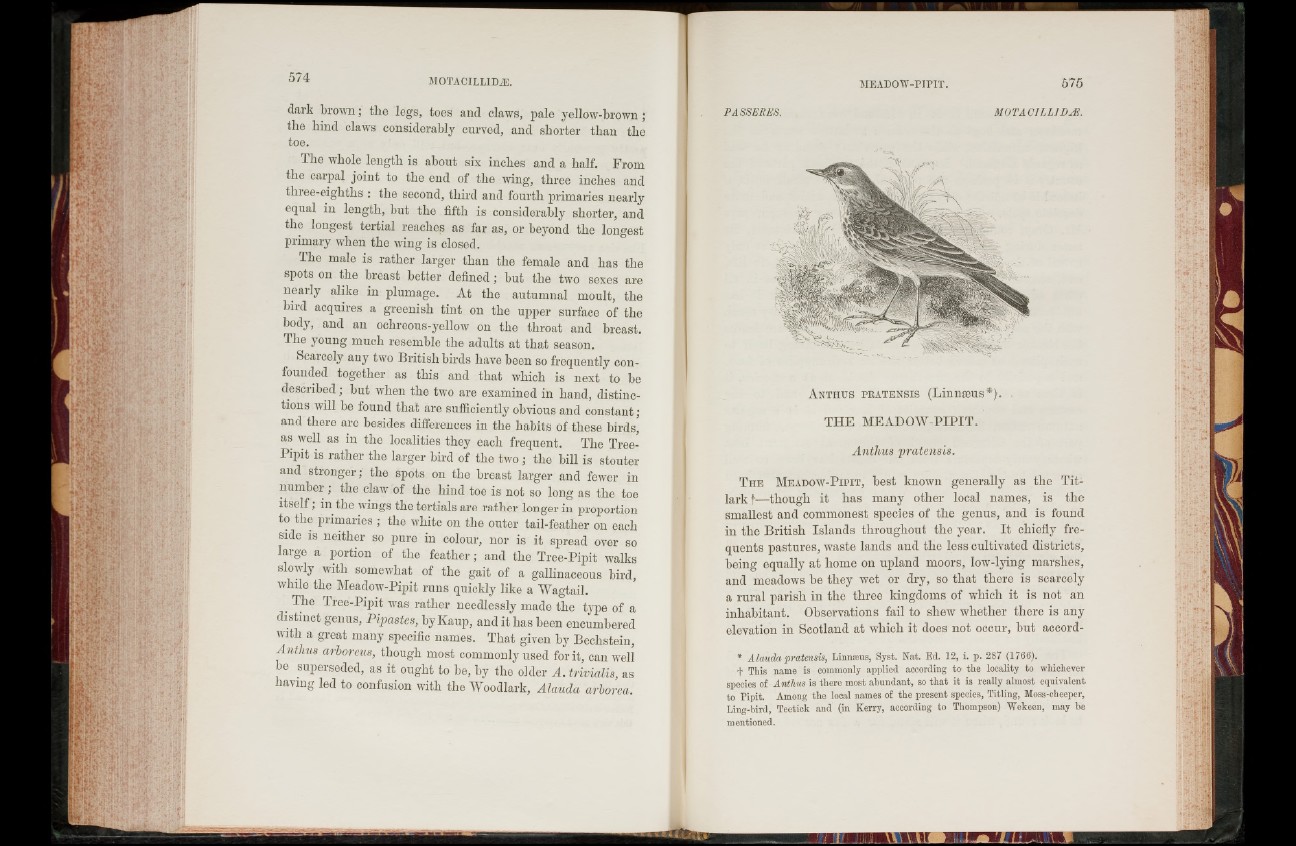
dark brown; the legs, toes and claws, pale yellow-brown;
the hind claws considerably curved, and shorter than the
toe.
The whole length is about six inches and a half. From
the carpal joint to the end of the wing, three inches and
thiee-eighths : the second, third and fourth primaries nearly
equal in length, but the fifth is considerably shorter, and
the longest tertial reaches as far as, or beyond the longest
primary when the wing is closed.
The male is rather larger than the female and has the
spots on the breast better defined; but the two sexes are
nearly alike in plumage. At the autumnal moult, the
bird acquires a greenish tint 011 the upper surface of the
body, and an ochreous-yellow on the throat and breast.
The young much resemble the adults at that season.
Scarcely any two British birds have been so frequently confounded
together as this and that which is next to be
described; but when the two are examined in hand, distinctions
will be found that are sufficiently obvious and constant ;
and there are besides differences in the habits of these birds,
as well as in the localities they each frequent. The Tree-
Pipit is rather the larger bird of the two ; the bill is stouter
and stronger; the spots on the breast larger and fewer in
number ; the claw of the hind toe is not so long as the toe
its e lf; in the wings the tertials are rather longer in proportion
to the primaries ; the white on the outer tail-feather on each
side is neither so pure in colour, nor is it spread over so
large a portion of the feather; and the Tree-Pipit walks
slowly with somewhat of the gait of a gallinaceous bird,
while the Meadow-Pipit runs quickly like a Wagtail.
The Tree-Pipit was rather needlessly made the type of a
distinct genus, Pipastes, by Ixaup, and it has been encumbered
with a great many specific names. That given by Beclistein,
Anthus arboreus, though most commonly used for it, can well
be superseded, as it ought to be, by the older A. trivialis, as
having led to confusion with the Woodlark, Alauda arborea.
A n t h u s p k a t e n s is (Linmeus*).
THE MEADOW-PIPIT.
Anthus pratensis.
T h e M ea d ow - P i p i t , best known generally as the Titlark
f—though it has many other local names, is the
smallest and commonest species of the genus, and is found
in the British Islands throughout the year. It chiefly frequents
pastures, waste lands and the less cultivated districts,
being equally at home on upland moors, low-lying marshes,
and meadows be they wet or dry, so that there is scarcely
a rural parish in the three kingdoms of which it is not an
inhabitant. Observations fail to shew whether there is any
elevation in Scotland at which it does not occur, but accord-
* Alauda pratensis, Linmeus, Syst. Nat. Ed. 12, i. p. 287 (1766).
+ This name is commonly applied according to the locality to -whichever
species of Anthus is there most abundant, so that it is really almost equivalent
to Pipit. Among the local names of the present species, Titling, Moss-cheeper,
Ling-bird, Teetick and (in Kerry, according to Thompson) Wekeen, may be
mentioned.